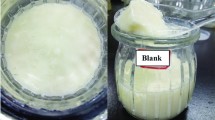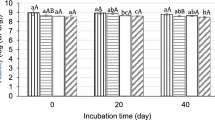Abstract
Objectives
This research paper was to investigate the influence of soybean peptides addition on viable count of lactic acid bacteria, physicochemical parameters, flavor, and sensory evaluation of yoghurt.
Results
The number of fermenting strains (Streptococcus thermophilus + Lactobacillus delbrueckii subsp. bulgaricus) cells in yoghurt (stored at 4 °C for 19 days) added with 0.2% (w/v) of soybean peptides (808.34 Da) reached 1.4 times higher bacterial number than in the control group. A total of 34 volatile substances were detected in this study, while there were 22 volatiles occurred in the control group yoghurt, 30 volatiles were detected in yoghurt added with 0.2% soybean peptides. There was no significant difference in sensory evaluation (p > 0.05) between the yoghurt with and without soybean peptides.
Conclusions
In our study, the addition of soybean peptides (0.2%) can be effective both in maintaining the viable bacterial count and yoghurt quality.




Similar content being viewed by others
References
Baú TR, Garcia S, Ida EI (2014) Evaluation of a functional soy product with addition of soy fiber and fermented with probiotic kefir culture. Braz Arch Biol Technol 57(3):402–409
Condurso C, Verzera A, Romeo V, Ziino M, Conte F (2008) Solid-phase microextraction and gas chromatography mass spectrometry analysis of dairy product volatiles for the determination of shelf-life. Int Dairy J 18(8):819–825
Darmawan R, Bringe N, de Mejia E (2010) Antioxidant capacity of alcalase hydrolysates and protein profiles of two conventional and seven low glycinin soybean cultivars. Plant Food Hum Nutr 65(3):233–240
Dave RI, Shah NP (1996) Evaluation of media for selective enumeration of Streptococcus thermophilus, Lactobacillus delbrueckii ssp. bulgaricus, Lactobacillus acidophilus, and Bifidobacteria. J Dairy Sci 79(9):1529–1536
Deguchi Y, Morishita T (1992) Nutritional requirements in multiple auxotrophic lactic acid bacteria: genetic lesions affecting amino acid biosynthetic pathways in Lactococcus lactis, Enterococcus faecium, and Pediococcus acidilactici. Biosci Biotechnol Biochem 56(6):913–918
Fan X, He X, Zhang A (2010) Studied on hyperplasia of Lactobacillus in milk supplemented with soybean peptides. Food Mach 1:89–91
Filannino P, Di Cagno R, Gobbetti M (2018) Metabolic and functional paths of lactic acid bacteria in plant foods: get out of the labyrinth. Curr Opin Biotechnol 49:64–72
Gao B, Zhao X (2012) Modification of soybean protein hydrolysates by alcalase-catalyzed plastein reaction and the ACE-inhibitory activity of the modified product in vitro. Int J Food Prop 15(5):982–996
Garault P, Letort C, Juillard V, Monnet V (2000) Branched-chain amino acid biosynthesis is essential for optimal growth of Streptococcus thermophilus in milk. Appl Environ Microbiol 66(12):5128–5133
García MC, Torre M, Marina ML, Laborda F, Rodriquez AR (1997) Composition and characterization of soyabean and related products. Crit Rev Food Sci Nutr 37(4):361–391
Gómez M, Oliete B, Rosell CM, Pando V, Fernández E (2008) Studies on cake quality made of wheat–chickpea flour blends. LWT Food Sci Technol 41(9):1701–1709
Govindaraju K, Srinivas H (2007) Controlled enzymatic hydrolysis of glycinin: susceptibility of acidic and basic subunits to proteolytic enzymes. LWT Food Sci Technol 40(6):1056–1065
Hols P, Frédéric H, Fontaine L, Grossiord B, Prozzi D, Leblond-Bourget N et al (2005) New insights in the molecular biology and physiology of Streptococcus thermophilus revealed by comparative genomics. FEMS Microbiol Rev 29(3):435–463
Iyer R, Tomar SK, Uma Maheswari T, Singh R (2010) Streptococcus thermophilus strains: multifunctional lactic acid bacteria. Int Dairy J 20(3):133–141
Izadi Z, Nasirpour A, Garoosi GA, Tamjidi F (2015) Rheological and physical properties of yogurt enriched with phytosterol during storage. J Food Sci Technol 52(8):5341–5346
Izawa S, Ikeda K, Takahashi N, Inoue Y (2007) Improvement of tolerance to freeze-thaw stress of baker’s yeast by cultivation with soy peptides. Appl Microbiol Biotechnol 75(3):533–537
Jensen PR, Hammer K (1993) Minimal requirements for exponential growth of Lactococcus lactis. Appl Environ Microbiol 59(12):4363–4366
Juillard V, Bars DL, Kunji ER, Konings WN, Gripon JC, Richard J (1995) Oligopeptides are the main source of nitrogen for Lactococcus lactis during growth in milk. Appl Environ Microbiol 61(8):3024–3030
Kitagawa S, Sugiyama M, Motoyama T, Abe F (2013) Soy peptides enhance yeast cell growth at low temperatures. Biotechnol Lett 35(3):375–382
Liu X, Li T, Liu B, Zhao H, Zhou F, Zhang B (2016a) An external addition of soy protein isolate hydrolysate to sourdough as a new strategy to improve the quality of Chinese steamed bread. J Food Qual 39(1):3–12
Liu M, Li Y, Zhang J, Liu X (2016b) Influence of soy peptides on yeast cells’ proliferation and tolerance to freeze-thaw stress. J Food Sci Technol 34(6):17–23
Makino S, Hemmi J, Kano H, Kashiwagi M, Hojo K, Asami Y (2018) Anti-fatigue effects of yogurt fermented with Lactobacillus delbureckii subsp. bulgaricus OLL1073R-1 in healthy people suffering from summer heat fatigue: a randomized, double-blind, placebo-controlled trial. Nutrients 10(7):798
Mark Hsieh C, Yang F, Iannotti EL (1999) The effect of soy protein hydrolyzates on fermentation by Lactobacillus amylovorus. Process Biochem 34(2):173–179
Mills O, Thomas T (1981) Nitrogen sources for growth of lactic Streptococci in milk. N Z J Dairy Sci Technol 16(1):43–55
Ojha KS, Mason TJ, O’Donnell CP, Kerry JP, Tiwari BK (2017) Ultrasound technology for food fermentation applications. Ultrason Sonochem 34:410–417
Ozer B, Bell A, Grandison A, Robinson R (1998) Rheological properties of concentrated yoghurt (labneh). J Texture Stud 29(1):67–79
Sahan N, Yasar K, Hayaloglu AA (2008) Physical, chemical and flavour quality of non-fat yogurt as affected by a β-glucan hydrocolloidal composite during storage. Food Hydrocoll 22(7):1291–1297
Singh BP, Vij S, Hati S (2014) Functional significance of bioactive peptides derived from soybean. Peptides 54:171–179
Wang X, Tang C, Li B, Li L, Yang X, Ma C (2008) Effects of high-pressure treatment on some physicochemical and functional properties of soy protein isolates. Food Hydrocoll 22(4):560–567
Wang X, Kristo E, LaPointe G (2019) The effect of apple pomace on the texture, rheology and microstructure of set type yogurt. Food Hydrocoll 91:83–91
Xu Y, Sun M, Zong X, Yang H, Zhao H (2019) Potential yeast growth and fermentation promoting activity of wheat gluten hydrolysates and soy protein hydrolysates during high-gravity fermentation. Ind Crops Prod 127:179–184
Yi G, Safdar B, Zhang Y, Li Y, Liu X (2020) A study of the mechanism of small-molecule soybean-protein-derived peptide supplement to promote sleep in a mouse model. RSC Adv 10(19):11264–11273
Zhao H, Bai F, Zhou F, Piotr W, Jiang X, Zhang B (2013) Characterization of soybean protein hydrolysates able to promote the proliferation of Streptococcus thermophilus ST. J Food Sci 78(4):M575–M581
Zhao F, Yu Y, Liu W, Zhang J, Liu X, Liu L, Yin H (2018) Small molecular weight soybean protein-derived peptides nutriment attenuates rat burn injury-induced muscle atrophy by modulation of ubiquitin–proteasome system and autophagy signaling pathway. J Agric Food Chem 66(11):2724–2734
Supporting information
Supplementary Table 1—Scheme of yoghurt sensory evaluation standards
Supplementary Table 2—Elution procedure for amino acids measurement by HPLC
Funding
This work was supported by National Key R&D Program of China (2016YFD0400401, 2018YFC1604205) and the Research Foundation for Youth Scholars of Beijing Technology and Business University.
Author information
Authors and Affiliations
Contributions
Conceptualization and Methodology: All authors; Formal analysis and investigation: Y.H.; Writing—original draft preparation: Y.L.; Writing—review and editing: All authors; Funding acquisition: X.L.; Resources: X.L.; Supervision: Y.L. and X.L.
Corresponding authors
Ethics declarations
Conflict of interest
All authors declare that they have no conflict of interest.
Ethical approval
This article does not contain any studies with human participants or animals performed by any of the authors.
Informed consent
Informed consent was obtained from all individual participants included in the study.
Additional information
Publisher's Note
Springer Nature remains neutral with regard to jurisdictional claims in published maps and institutional affiliations.
Electronic supplementary material
Below is the link to the electronic supplementary material.
Rights and permissions
About this article
Cite this article
Hu, Y., Li, Y. & Liu, X. Soybean peptides promote yoghurt fermentation and quality. Biotechnol Lett 42, 1927–1937 (2020). https://doi.org/10.1007/s10529-020-02912-2
Received:
Accepted:
Published:
Issue Date:
DOI: https://doi.org/10.1007/s10529-020-02912-2




